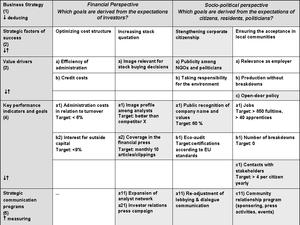Scorecards/Strategy Maps
1. Definition
Scorecards and Strategy Maps are based on the Balanced Scorecard Method developed by Robert S. Kaplan and David P. Norton. The Balanced Scorecard is an indicator-based strategic performance and management system. A Balanced Scorecard factors in both quantitative and qualitative control variables and concretizes strategic goals in the form of indicators. Organizations and processes are analyzed from various perspectives (Financial, Customer, Internal Business Processes, and Learning and Growth). Financial and non-financial indicators are combined in one and the same concept. The basis is the organization's strategy and vision. Strategy Maps is a further development, it is a strategy management system. The purpose is to show how the company generates value. The strategic goals to be followed for that purpose are inter-linked in the four scorecard perspectives (Financial, Customers, Internal Business Processes, Learning and Growth) by explicit cause-effect relationships.
2. Applications
Originally developed for value-based management, the approach allows users to show the contribution of Corporate Communication to commercial success and include it in the control process. Scorecards and Strategy Maps show the links between communication targets and corporate objectives, and allow the presentation of mutual influences and the measurement and control of change.
There are two levels of application: The system can be used as a higher-order company-wide system for controlling corporate strategy, and it can be used at the structural level for operative control of communication programs and measures. In addition to the Financial perspective, the Customer, Processes and Learning and Growth perspectives (see definition) are included in each case. Some approaches use additional perspectives (see Zerfaß, Social Policy Perspective). The general principle is to illustrate the impact of communication on key business processes, and to investigate both strategic and operative action. This enables corporate and communication strategies, their implementation and interaction to be communicated comprehensibly within the organization. The transparency of the cause-effect structure allows managers, departments and involved parties to recognize their contribution to goal accomplishment and ideally also to recognize the associated implications for the company's commercial success. The greatest challenge involved is to identify relevant and important success factors and value drivers, and match them to the "right" Key Performance Indicators (KPIs).
Key performance indicators reveal non goal-directed measures, which can then be adjusted accordingly. Like corporate processes, Scorecards and Strategy Maps must be updated on a continual basis.
3. Implementation
The development of Scorecards and Strategy Maps involves numerous interpersonal coordination processes and agreements. Cause-effect relationships for the key indicators are determined, usually at the level of top management. A framework PR concept is developed on the basis of corporate vision and strategy, taking into account the various perspectives (see above) and the particular stakeholder focus. A consensus in terms of success factors, value drivers and KPIs is reached for each perspective. The indicators can then be transferred to strategic and operative communication programs and shaped to meet the target objectives.
4. Indicators
It is important to ensure that each indicator is generated using a suitable measurement method in order to obtain meaningful data and values that can be observed over a prolonged period of time. Indicators such as given in the adjacent example are typical. Indicators are investigated at regular intervals and compared with the target values. In the event of deviations between nominal and actual values, strategic programs or objectives may be adjusted - depending on the overriding value driver, success factor, or underlying cause-effect chain. This has the effect of initiating a concomitant learning process in the organization.
5. Service providers
The best known scorecard methods are Hering Schuppener's Communication Scorecard und Zerfaß's Corporate Communication Scorecard [PDF in german]. The GPRA's Communication Value System (the approach is implemented individually by the agencies belonging to the GPRA) and Pfannenberg's Value Based Management approach (JP|KOM) are similar in approach.
Key aspects of the scorecard approach are also used in the integrated systems.
All approaches must be adapted to suit the organizations deploying them. This entails comparatively high consulting costs and implementation times. Kaplan and Norton estimate a prolonged process of approximately 12 to 18 months' duration for a complete corporate control process by the Balanced Scorecard method. This horizon also seems realistic when using this approach for the areas of corporate communications and communications controlling.
6. Links
www.balancedscorecard.org - The Balanced Scorecard Institute helps organizations succeed through improved strategic focus and performance.
www.valuebasedmanagement.net - Management Methods | Management Models | Management Theories
en.wikipedia.org/wiki/Balanced_scorecard - Wikipedia article "Balanced scorecard"
7. Further reading
Robert S. Kaplan/David P. Norton (1992). The Balanced Scorecard - Measures that Drive Performance. In: Harvard Business Review. January-February 1992, pp. 71-79.
Zerfass, A. (2008). The Corporate Communications Scorecard – A framework for managing and evaluating communication strategies. In B. van Ruler, A. Tkalac Vercic & D. Vercic (Eds.), Public Relations Metrics: Research and Evaluation (pp. 139-153). Mahwah, NJ: Routledge.
8. Case studies
Please send us short texts from your projects on this topic in the same structure as the existing case studies, and more information (pdf or links) on the methods employed in as much detail as possible.
Contact: redaktion communicationcontrolling.de
communicationcontrolling.de


